light FIAT DUCATO BASE CAMPER 2018 Owner handbook (in English)
[x] Cancel search | Manufacturer: FIAT, Model Year: 2018, Model line: DUCATO BASE CAMPER, Model: FIAT DUCATO BASE CAMPER 2018Pages: 304, PDF Size: 14.93 MB
Page 96 of 304

vehicle direction getting constantly
closer to the lane demarcation lines (the
vehicle trajectory is within the lane
demarcation lines);
vehicle not constantly next to the
lane demarcation line.
ACTIVATING/
DEACTIVATING THE
SYSTEM
When the system is active, if the vehicle
gets close to one of the side
demarcation lines or one of the two
lane demarcation lines, the driver is
warned with an acoustic signal (coming
from the crossed line side if the vehicle
is equipped with the radio navigation
system) along with the corresponding
direction warning light (
or) lighting
up.
If the driver turns on the direction
indicator in order to change lanes or for
overtaking, then the system will switch
off the driver warning.
If the driver keeps deliberately with the
lane change manoeuvre, the system
interrupts the warning, remaining
enabled if the operating conditions are
not satisfied or active if the operating
conditions are exceeded (see the
dedicated paragraph).SWITCHING OFF THE
SYSTEM
Manual mode
The system can be switched off by
pressing button A fig. 104 on the
dashboard.
The LED on the button switches on and
a message appears on the display to
confirm that the system has been
switched off.
Automatic mode
If the Start&Stop is active the system
deactivates automatically. The system
will reactivate and check its operating
conditions again after the vehicle has
been started.
SYSTEM FAILURE
In the event of malfunction, the system
signals the fault to the driver with a
message on the display, an acoustic
warning and by turning on the
icon
on the display (for versions/markets,
where provided).
IMPORTANT NOTES
The Driving Advisor cannot operate due
to a not perfectly balanced and
excessive load.The operation of the system can be
adversely affected in some cases
by the morphology of the territory/road
being driven on (e.g. driving over
humps), poor visibility conditions (e.g.
fog, rain, snow), extreme light
conditions (e.g. glare of the sun,
darkness), lack of cleanliness
or damage, even partial, to the
windscreen in the area in front of the
camera.
The Driving Advisor cannot operate
following a malfunction of the following
safety systems: ABS, ESC, ASR and
Traction Plus.
The operation of the system can be
adversely affected by poor visibility
conditions (e.g. fog, rain, snow),
extreme light conditions (glare of the
sun, darkness), lack of cleaning or
damage, even partial, to the
windscreen in the area in front the
camera.
The area of the windscreen by the
camera must not be partly or totally
obscured by objects (e.g. stickers,
protective film, etc.).
94
SAFETY
Page 98 of 304
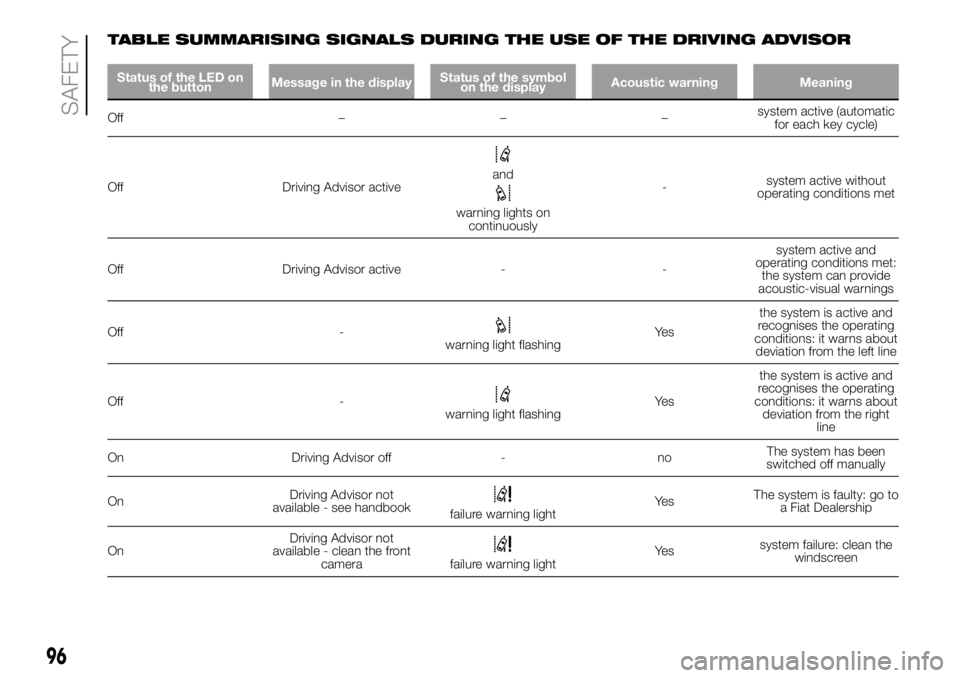
TABLE SUMMARISING SIGNALS DURING THE USE OF THE DRIVING ADVISOR
Status of the LED on
the buttonMessage in the displayStatus of the symbol
on the displayAcoustic warning Meaning
Off –––system active (automatic
for each key cycle)
Off Driving Advisor active
and
warning lights on
continuously-system active without
operating conditions met
Off Driving Advisor active - -system active and
operating conditions met:
the system can provide
acoustic-visual warnings
Off -
warning light flashingYe sthe system is active and
recognises the operating
conditions: it warns about
deviation from the left line
Off -
warning light flashingYe sthe system is active and
recognises the operating
conditions: it warns about
deviation from the right
line
On Driving Advisor off - noThe system has been
switched off manually
OnDriving Advisor not
available - see handbook
failure warning lightYe sThe system is faulty: go to
a Fiat Dealership
OnDriving Advisor not
available - clean the front
camera
failure warning lightYe ssystem failure: clean the
windscreen
96
SAFETY
Page 100 of 304
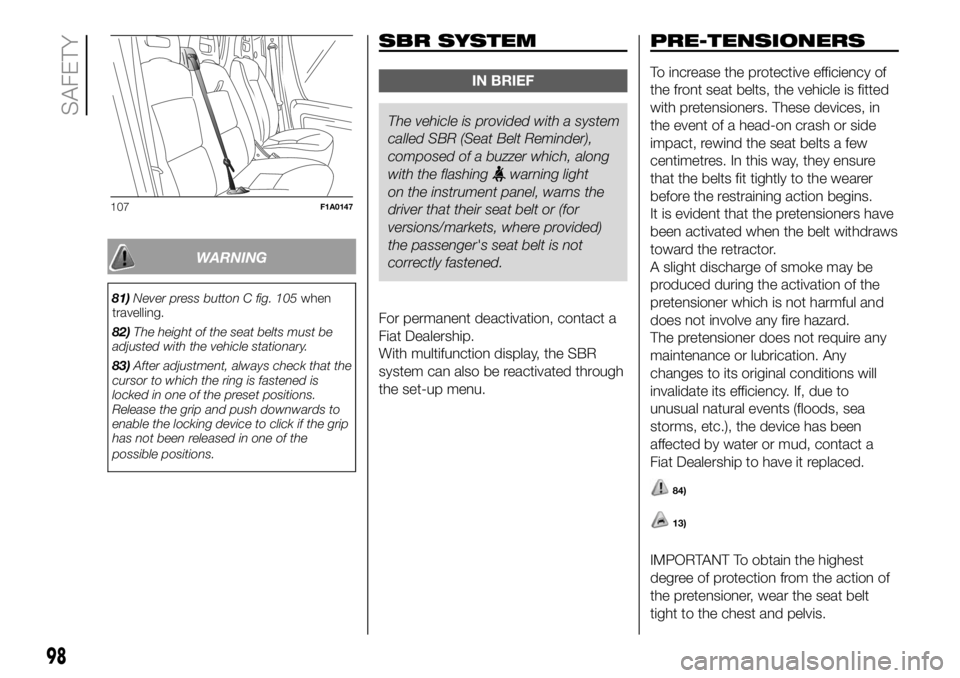
WARNING
81)Never press button C fig. 105when
travelling.
82)The height of the seat belts must be
adjusted with the vehicle stationary.
83)After adjustment, always check that the
cursor to which the ring is fastened is
locked in one of the preset positions.
Release the grip and push downwards to
enable the locking device to click if the grip
has not been released in one of the
possible positions.
SBR SYSTEM
IN BRIEF
The vehicle is provided with a system
called SBR (SeatBelt Reminder),
composed of a buzzer which, along
with the flashing
warning light
on the instrument panel, warns the
driver that their seat belt or (for
versions/markets, where provided)
the passenger's seat belt is not
correctly fastened.
For permanent deactivation, contact a
Fiat Dealership.
With multifunction display, the SBR
system can also be reactivated through
the set-up menu.
PRE-TENSIONERS
To increase the protective efficiency of
the front seat belts, the vehicle is fitted
with pretensioners. These devices, in
the event of a head-on crash or side
impact, rewind the seat belts a few
centimetres. In this way, they ensure
that the belts fit tightly to the wearer
before the restraining action begins.
It is evident that the pretensioners have
been activated when the belt withdraws
toward the retractor.
A slight discharge of smoke may be
produced during the activation of the
pretensioner which is not harmful and
does not involve any fire hazard.
The pretensioner does not require any
maintenance or lubrication. Any
changes to its original conditions will
invalidate its efficiency. If, due to
unusual natural events (floods, sea
storms, etc.), the device has been
affected by water or mud, contact a
Fiat Dealership to have it replaced.
84)
13)
IMPORTANT To obtain the highest
degree of protection from the action of
the pretensioner, wear the seat belt
tight to the chest and pelvis.
107F1A0147
98
SAFETY
Page 114 of 304
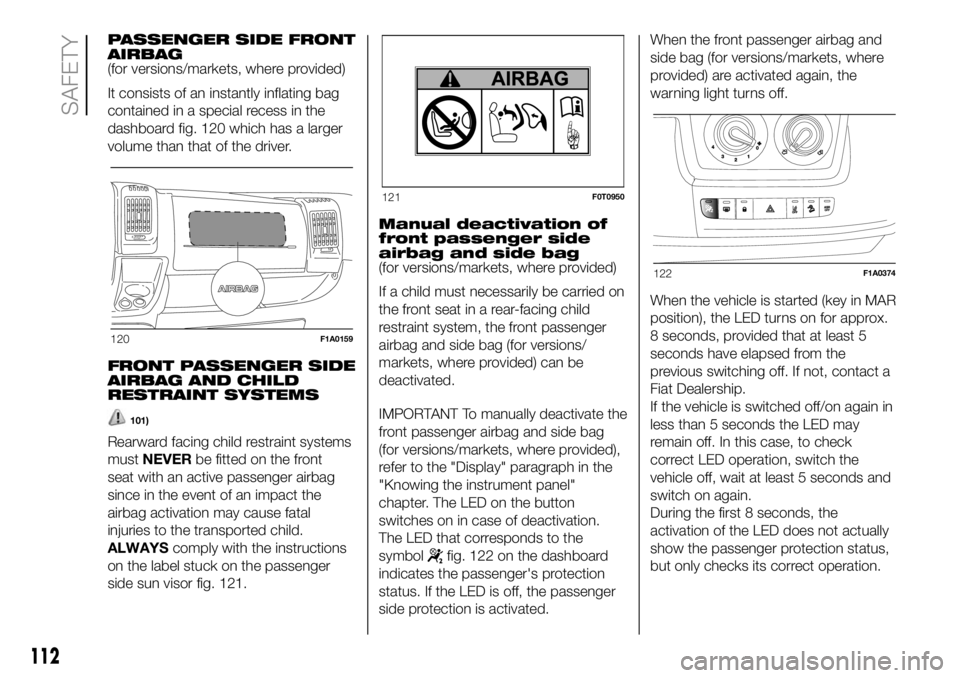
PASSENGER SIDE FRONT
AIRBAG
(for versions/markets, where provided)
It consists of an instantly inflating bag
contained in a special recess in the
dashboard fig. 120 which has a larger
volume than that of the driver.
FRONT PASSENGER SIDE
AIRBAG AND CHILD
RESTRAINT SYSTEMS
101)
Rearward facing child restraint systems
mustNEVERbe fitted on the front
seat with an active passenger airbag
since in the event of an impact the
airbag activation may cause fatal
injuries to the transported child.
ALWAYScomply with the instructions
on the label stuck on the passenger
side sun visor fig. 121.Manual deactivation of
front passenger side
airbag and side bag
(for versions/markets, where provided)
If a child must necessarily be carried on
the front seat in a rear-facing child
restraint system, the front passenger
airbag and side bag (for versions/
markets, where provided) can be
deactivated.
IMPORTANT To manually deactivate the
front passenger airbag and side bag
(for versions/markets, where provided),
refer to the "Display" paragraph in the
"Knowing the instrument panel"
chapter. The LED on the button
switches on in case of deactivation.
The LED that corresponds to the
symbol
fig. 122 on the dashboard
indicates the passenger's protection
status. If the LED is off, the passenger
side protection is activated.When the front passenger airbag and
side bag (for versions/markets, where
provided) are activated again, the
warning light turns off.
When the vehicle is started (key in MAR
position), the LED turns on for approx.
8 seconds, provided that at least 5
seconds have elapsed from the
previous switching off. If not, contact a
Fiat Dealership.
If the vehicle is switched off/on again in
less than 5 seconds the LED may
remain off. In this case, to check
correct LED operation, switch the
vehicle off, wait at least 5 seconds and
switch on again.
During the first 8 seconds, the
activation of the LED does not actually
show the passenger protection status,
but only checks its correct operation.
120F1A0159
121F0T0950
122F1A0374
112
SAFETY
Page 115 of 304
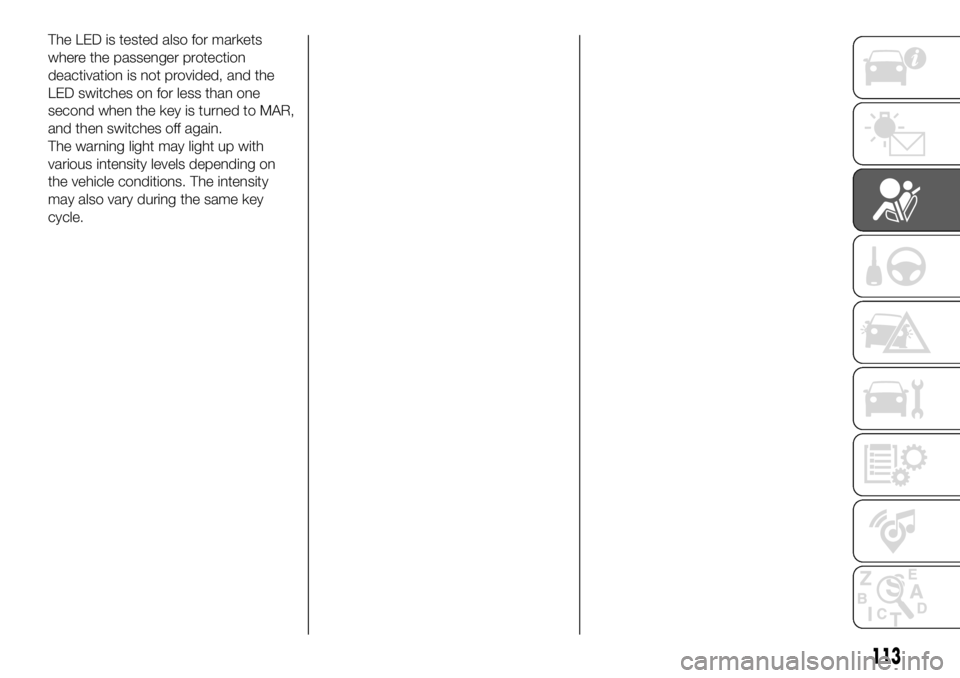
The LED is tested also for markets
where the passenger protection
deactivation is not provided, and the
LED switches on for less than one
second when the key is turned to MAR,
and then switches off again.
The warning light may light up with
various intensity levels depending on
the vehicle conditions. The intensity
may also vary during the same key
cycle.
113
Page 118 of 304

IMPORTANT A small amount of dust
will be released when the airbags
are deployed. The dust is not harmful
and does not indicate the beginning of
a fire. Furthermore, the surface of the
deployed bag and the interior of the
vehicle may be covered in a dusty
residue: this may irritate your skin and
eyes. Wash with mild soap and water in
the event of exposure.
IMPORTANT Should an accident occur
in which any of the safety devices are
activated, take the vehicle to a Fiat
Dealership to have the activated
devices replaced and to have the whole
system checked.
Every control, repair and replacement
operation concerning the airbags must
be carried out only at Fiat Dealerships.
If you are having the vehicle scrapped,
have the system deactivated at a Fiat
Dealership first. If the vehicle changes
ownership, the new owner must be
informed of how to use the airbags and
the above warnings and also be given
this "Owner Handbook".
IMPORTANT Pretensioners, front
airbags and front side bags are
deployed differently according to the
type of collision. Failure to activate one
or more of the devices does not
indicate a system malfunction.
WARNING
100)Do not apply stickers or other objects
to the steering wheel, the dashboard in
the passenger side airbag area and the
seats. Never put objects (e.g. mobile
phones) on the passenger side of the
dashboard since they could interfere with
correct inflation of the passenger airbag
and also cause serious injury to the
passengers.
101)When there is an active passenger
airbag, DO NOT install rearward facing
child restraint systems on the front seat.
Deployment of the airbag in an accident
could cause fatal injuries to the child
regardless of the severity of the impact.
Therefore, always deactivate the passenger
side airbag when a rearward facing child
restraint system is installed on the front
passenger seat. The front passenger seat
must also be positioned back as far as
possible in order to prevent the child
restraint system from coming into contact
with the dashboard. Immediately reactivate
the passenger airbag as soon as the child
restraint system has been removed.
102)Never rest head, arms and elbows on
the doors, on the windows and in the
side air bag head protection area (Window
Bag) to prevent possible injuries during
inflation phase.
103)Never lean your head, arms or elbows
out of the window.104)If when turning the key to MAR the
warning light
does not turn on or if
it stays on when travelling (together with
the message on the multifunction display,
for versions/markets where provided), there
could be a fault in the safety systems; in
this event, airbags or pretensioners may
not trigger in the case of impact or, in
a lower number of cases, they could be
triggered accidentally. Contact a Fiat
Dealership immediately to have the system
checked.
105)Do not cover the backrest of the front
or rear seats with covers which are not
suitable for use with side bags.
106)Do not travel carrying objects in your
lap, in front of your chest or between
your lips (pipe, pencils, etc.): they could
cause severe injury if the airbag is
deployed.
107)Always drive keeping your hands on
the steering wheel rim so the airbag can
inflate freely if necessary. Do not drive with
your body bent forward. Keep your back
straight against the backrest.
116
SAFETY
Page 119 of 304
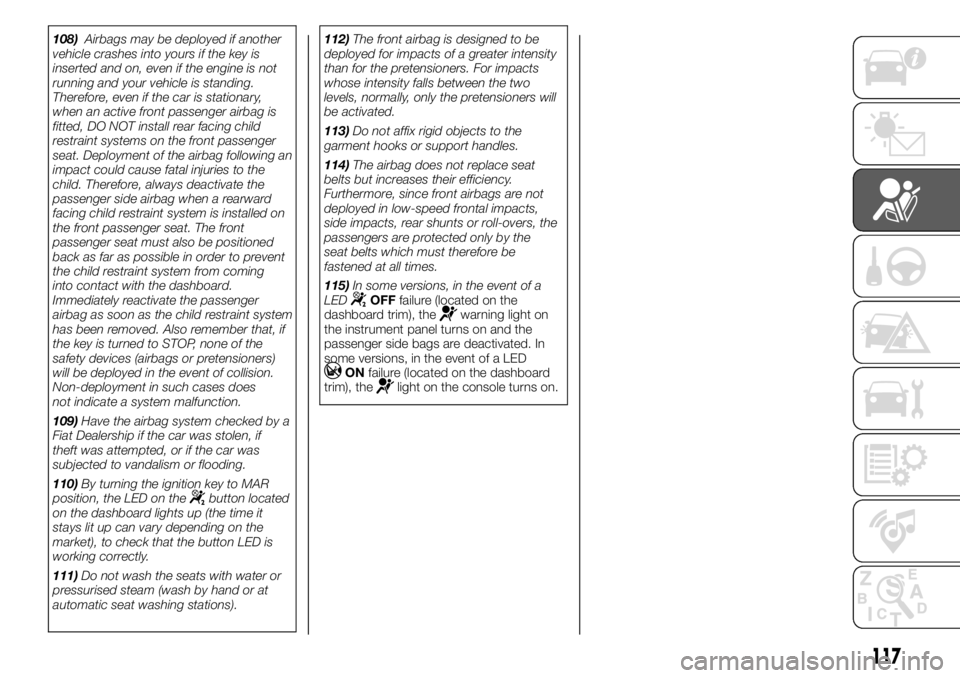
108)Airbags may be deployed if another
vehicle crashes into yours if the key is
inserted and on, even if the engine is not
running and your vehicle is standing.
Therefore, even if the car is stationary,
when an active front passenger airbag is
fitted, DO NOT install rear facing child
restraint systems on the front passenger
seat. Deployment of the airbag following an
impact could cause fatal injuries to the
child. Therefore, always deactivate the
passenger side airbag when a rearward
facing child restraint system is installed on
the front passenger seat. The front
passenger seat must also be positioned
back as far as possible in order to prevent
the child restraint system from coming
into contact with the dashboard.
Immediately reactivate the passenger
airbag as soon as the child restraint system
has been removed. Also remember that, if
the key is turned to STOP, none of the
safety devices (airbags or pretensioners)
will be deployed in the event of collision.
Non-deployment in such cases does
not indicate a system malfunction.
109)Have the airbag system checked by a
Fiat Dealership if the car was stolen, if
theft was attempted, or if the car was
subjected to vandalism or flooding.
110)By turning the ignition key to MAR
position, the LED on the
button located
on the dashboard lights up (the time it
stays lit up can vary depending on the
market), to check that the button LED is
working correctly.
111)Do not wash the seats with water or
pressurised steam (wash by hand or at
automatic seat washing stations).112)The front airbag is designed to be
deployed for impacts of a greater intensity
than for the pretensioners. For impacts
whose intensity falls between the two
levels, normally, only the pretensioners will
be activated.
113)Do not affix rigid objects to the
garment hooks or support handles.
114)The airbag does not replace seat
belts but increases their efficiency.
Furthermore, since front airbags are not
deployed in low-speed frontal impacts,
side impacts, rear shunts or roll-overs, the
passengers are protected only by the
seat belts which must therefore be
fastened at all times.
115)In some versions, in the event of a
LED
OFFfailure (located on the
dashboard trim), thewarning light on
the instrument panel turns on and the
passenger side bags are deactivated. In
some versions, in the event of a LED
ONfailure (located on the dashboard
trim), thelight on the console turns on.
117
Page 121 of 304
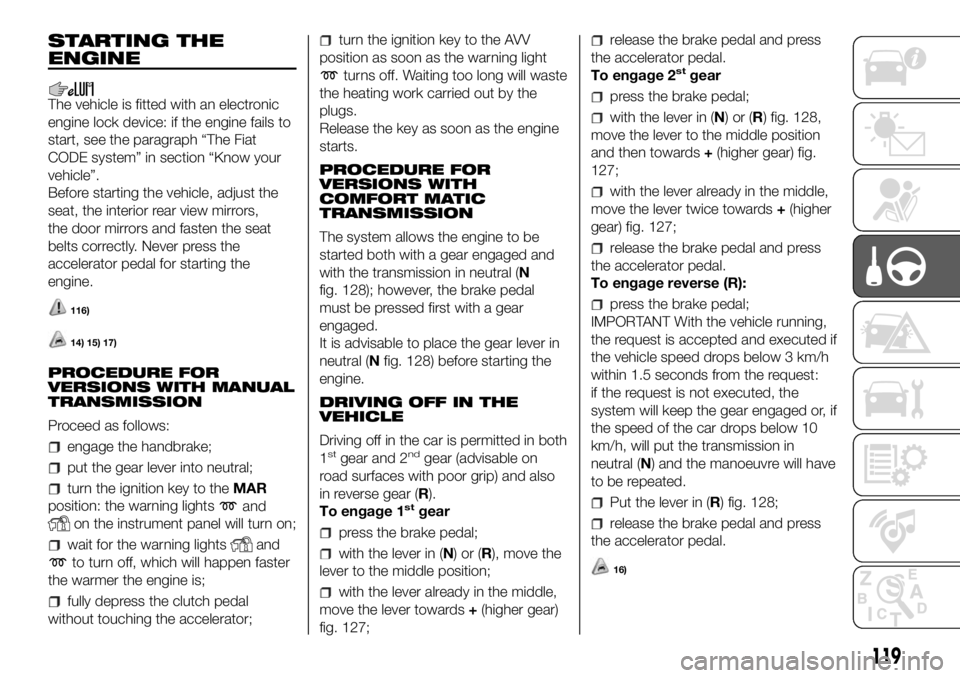
STARTING THE
ENGINE
The vehicle is fitted with an electronic
engine lock device: if the engine fails to
start, see the paragraph “The Fiat
CODE system” in section “Know your
vehicle”.
Before starting the vehicle, adjust the
seat, the interior rear view mirrors,
the door mirrors and fasten the seat
belts correctly. Never press the
accelerator pedal for starting the
engine.
116)
14) 15) 17)
PROCEDURE FOR
VERSIONS WITH MANUAL
TRANSMISSION
Proceed as follows:
engage the handbrake;
put the gear lever into neutral;
turn the ignition key to theMAR
position: the warning lights
and
on the instrument panel will turn on;
wait for the warning lightsand
to turn off, which will happen faster
the warmer the engine is;
fully depress the clutch pedal
without touching the accelerator;
turn the ignition key to the AVV
position as soon as the warning light
turns off. Waiting too long will waste
the heating work carried out by the
plugs.
Release the key as soon as the engine
starts.
PROCEDURE FOR
VERSIONS WITH
COMFORT MATIC
TRANSMISSION
The system allows the engine to be
started both with a gear engaged and
with the transmission in neutral (N
fig. 128); however, the brake pedal
must be pressed first with a gear
engaged.
It is advisable to place the gear lever in
neutral (Nfig. 128) before starting the
engine.
DRIVING OFF IN THE
VEHICLE
Driving off in the car is permitted in both
1
stgear and 2ndgear (advisable on
road surfaces with poor grip) and also
in reverse gear (R).
To engage 1
stgear
press the brake pedal;
with the lever in (N)or(R), move the
lever to the middle position;
with the lever already in the middle,
move the lever towards+(higher gear)
fig. 127;
release the brake pedal and press
the accelerator pedal.
To engage 2
stgear
press the brake pedal;
with the lever in (N)or(R) fig. 128,
move the lever to the middle position
and then towards+(higher gear) fig.
127;
with the lever already in the middle,
move the lever twice towards+(higher
gear) fig. 127;
release the brake pedal and press
the accelerator pedal.
To engage reverse (R):
press the brake pedal;
IMPORTANT With the vehicle running,
the request is accepted and executed if
the vehicle speed drops below 3 km/h
within 1.5 seconds from the request:
if the request is not executed, the
system will keep the gear engaged or, if
the speed of the car drops below 10
km/h, will put the transmission in
neutral (N) and the manoeuvre will have
to be repeated.
Put the lever in (R) fig. 128;
release the brake pedal and press
the accelerator pedal.
16)
119
Page 122 of 304
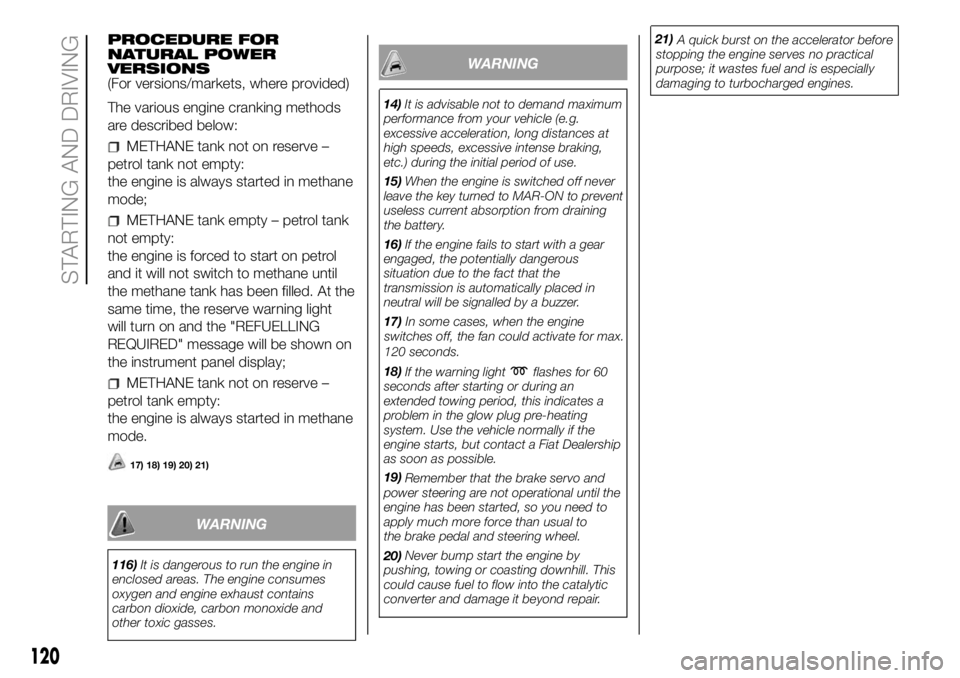
PROCEDURE FOR
NATURAL POWER
VERSIONS
(For versions/markets, where provided)
The various engine cranking methods
are described below:
METHANE tank not on reserve –
petrol tank not empty:
the engine is always started in methane
mode;
METHANE tank empty – petrol tank
not empty:
the engine is forced to start on petrol
and it will not switch to methane until
the methane tank has been filled. At the
same time, the reserve warning light
will turn on and the "REFUELLING
REQUIRED" message will be shown on
the instrument panel display;
METHANE tank not on reserve –
petrol tank empty:
the engine is always started in methane
mode.
17) 18) 19) 20) 21)
WARNING
116)It is dangerous to run the engine in
enclosed areas. The engine consumes
oxygen and engine exhaust contains
carbon dioxide, carbon monoxide and
other toxic gasses.
WARNING
14)It is advisable not to demand maximum
performance from your vehicle (e.g.
excessive acceleration, long distances at
high speeds, excessive intense braking,
etc.) during the initial period of use.
15)When the engine is switched off never
leave the key turned to MAR-ON to prevent
useless current absorption from draining
the battery.
16)If the engine fails to start with a gear
engaged, the potentially dangerous
situation due to the fact that the
transmission is automatically placed in
neutral will be signalled by a buzzer.
17)
If the warning light
flashes for 60
seconds after starting or during an
extended towing period, this indicates a
problem in the glow plug preheating
system. Use the vehicle normally if the
engine starts, but contact a Fiat Dealership
as soon as possible. 18)
Remember that the brake servo and
power steering are not operational until the
engine has been started, so you need to
apply much more force than usual to
the brake pedal and steering wheel. 19)
Never bump start the engine by
pushing, towing or coasting downhill. This
could cause fuel to flow into the catalytic
converter and damage it beyond repair. 20)A quick burst on the accelerator before
stopping the engine serves no practical
purpose; it wastes fuel and is especially
damaging to turbocharged engines. 21)
In some cases, when the engine
switches off, the fan could activate for max.
120 seconds.
120
STARTING AND DRIVING
Page 124 of 304
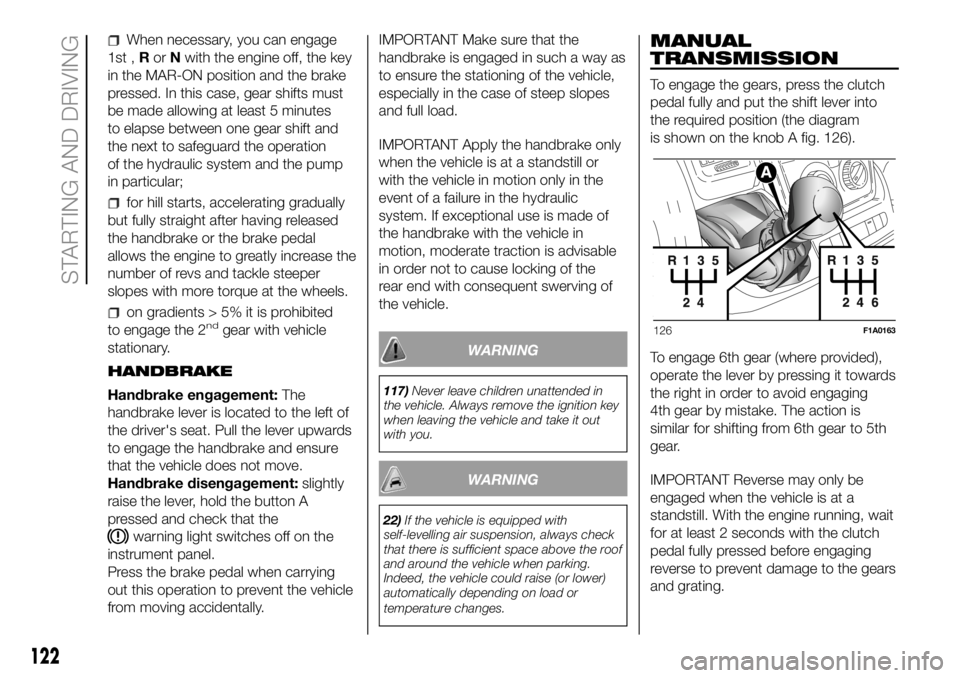
When necessary, you can engage
1st ,RorNwith the engine off, the key
in the MAR-ON position and the brake
pressed. In this case, gear shifts must
be made allowing at least 5 minutes
to elapse between one gear shift and
the next to safeguard the operation
of the hydraulic system and the pump
in particular;
for hill starts, accelerating gradually
but fully straight after having released
the handbrake or the brake pedal
allows the engine to greatly increase the
number of revs and tackle steeper
slopes with more torque at the wheels.
on gradients > 5% it is prohibited
to engage the 2ndgear with vehicle
stationary.
HANDBRAKE
Handbrake engagement:The
handbrake lever is located to the left of
the driver's seat. Pull the lever upwards
to engage the handbrake and ensure
that the vehicle does not move.
Handbrake disengagement:slightly
raise the lever, hold the button A
pressed and check that the
warning light switches off on the
instrument panel.
Press the brake pedal when carrying
out this operation to prevent the vehicle
from moving accidentally.IMPORTANT Make sure that the
handbrake is engaged in such a way as
to ensure the stationing of the vehicle,
especially in the case of steep slopes
and full load.
IMPORTANT Apply the handbrake only
when the vehicle is at a standstill or
with the vehicle in motion only in the
event of a failure in the hydraulic
system. If exceptional use is made of
the handbrake with the vehicle in
motion, moderate traction is advisable
in order not to cause locking of the
rear end with consequent swerving of
the vehicle.
WARNING
117)Never leave children unattended in
the vehicle. Always remove the ignition key
when leaving the vehicle and take it out
with you.
WARNING
22)If the vehicle is equipped with
self-levelling air suspension, always check
that there is sufficient space above the roof
and around the vehicle when parking.
Indeed, the vehicle could raise (or lower)
automatically depending on load or
temperature changes.
MANUAL
TRANSMISSION
To engage the gears, press the clutch
pedal fully and put the shift lever into
the required position (the diagram
is shown on the knob A fig. 126).
To engage 6th gear (where provided),
operate the lever by pressing it towards
the right in order to avoid engaging
4th gear by mistake. The action is
similar for shifting from 6th gear to 5th
gear.
IMPORTANT Reverse may only be
engaged when the vehicle is at a
standstill. With the engine running, wait
for at least 2 seconds with the clutch
pedal fully pressed before engaging
reverse to prevent damage to the gears
and grating.
126F1A0163
122
STARTING AND DRIVING